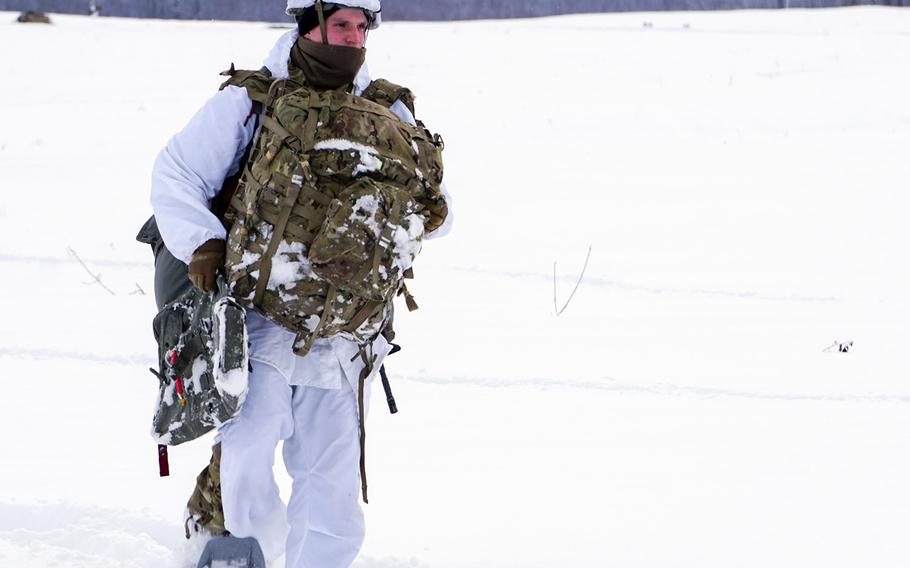
About 1,000 soldiers from the 4th Infantry Brigade Combat Team, 25th Infantry Division at Joint Base Elmendorf-Richardson in Anchorage, Alaska, were issued in January a wearable device to measure their physiological data in an effort to improve the resiliency of soldiers operating in harsh conditions. (McSaatchi Sports and Entertainment)
AUSTIN, Texas – To better understand how sleep helps soldiers cope in the harsh conditions of Alaska, about 1,000 Army troops at Joint Base Elmendorf-Richardson in Anchorage have been issued a wearable device to measure their physiological data across sleep, strain and recovery.
In January, soldiers of the 4th Infantry Brigade Combat Team, 25th Infantry Division, wore the device while training for 11 days in temperatures that some nights dropped as low as -40 degrees. Now leaders can review that aggregate data to understand what it takes for soldiers to recover and make changes to improve resiliency during future training, said Chief Warrant Officer 4 Phillip Ranck, a project manager with SPARwerx, an innovation hub of the brigade that looks for ways to apply technology and civilian processes to improve the brigade.
“You don’t see [data] piece by piece, but it still paints the picture of how long it takes us as a group to collectively get back to healthy and move forward to our next iteration,” he said. “It’s that resiliency aspect that we are really looking at.”
Over six months, the WHOOP brand device will collect data on internal and external stressors, then offer ways to improve recovery and create positive behaviors. Each soldier can see the data through a smartphone app, and commanders can see an overall collection of data to determine the well-being of the unit. Soldiers also completed detailed questionnaires as part of the study and will complete others when it ends. The study is being done in collaboration with the University of Queensland in Australia.
SPARwerx chose the WHOOP device in part because it does not have wifi or GPS tracking capabilities, is durable, has batteries that last for five days and includes on-the-go charging. It’s meant to be worn as much as possible and measures strain on the body during exercise, daily activities and psychological stress, according to the company. It then tracks sleep and creates a score of how well-recovered a person is from strain the previous day.
“We’re hoping to provide insight into how the personal, psychological and situational factors … all interact to produce either adaptive and maladaptive stress responses of military personnel who are operating in these really extreme arctic temps. It’s not just the temperatures, but the darkness,” said Kristen Holmes, WHOOP vice president of performance science. “I think what we really want to understand is, these folks are already really resilient, but how does stress manifest and is it manifesting in an adaptive or a maladaptive way?”
The device determines a person’s recovery through resting heart rate, heart rate variability and respiratory rate, which is measured during sleep. The heart rate variability measures the body’s ability to adapt to stress, Holmes said.
“We’re not only looking at psychological measures, but we’re also looking at physiological measures and really provide a clear picture on what human resilience really looks like,” she said.
Through the app, WHOOP makes suggestions on how much sleep is needed to recover from the strain of the day. Soon, two groups of soldiers will receive a message through the app encouraging a specific behavior change. A third group of soldiers will not receive a recommendation.
All interventions are related to circadian alignment, or a person’s sleep-wake cycle, Holmes said, being intentionally vague to not compromise the study. Behaviors that determine whether a person has an aligned circadian clock are the regularity of the sleep-wake cycle, exposure to light and darkness, and meal timing.
“All of these things impact the quality of sleep, which then will impact our heart rate variability,” Holmes said.
She hopes that researchers can provide leaders recommendations on better timing of meals, sleep and light exposure during operations in harsh conditions, she said. These changes don’t cost anything and can have a clear impact.
“The motivation for this, I can tell you that it’s coming from the most sincere place of wanting to stamp out suicide and mental health issues and empower these individuals with the information they need to adopt behaviors … to thrive in this environment,” Holmes said.
After two months with his device, Ranck said he has learned that late-night snacking impacts his recovery during sleep, and he’s trying to cut it out. He said he does what’s required of physical fitness for the Army, but he’s never worn a device such as WHOOP and he doesn’t hit the gym every day.
“I’m really happy to see a program like this. I’ve been in for 24 years and I do the best that I can for the Army on a regular basis. I think I know what makes me healthy. In the end, I’ve grown up a mechanic and logistician. I’m not a doctor,” he said. “Once I put this on it changed that for me and it started to show me the effects on my body, not just through the Army, but how I conduct myself after the Army and at home. … It’s really kind of helped me, later in my career unfortunately, learn how to be the best version of myself.”
Once the study concludes in June, it will be submitted for peer review.
Thayer.rose@stripes.com Twitter: @Rose_Lori